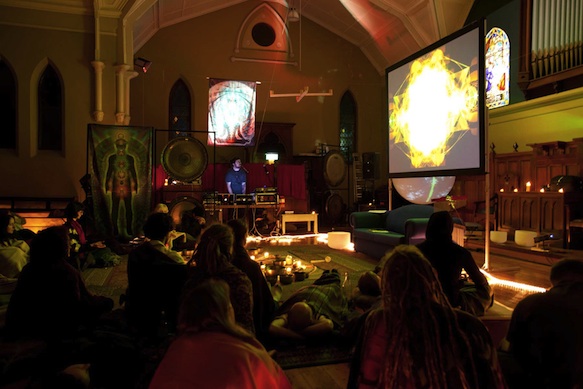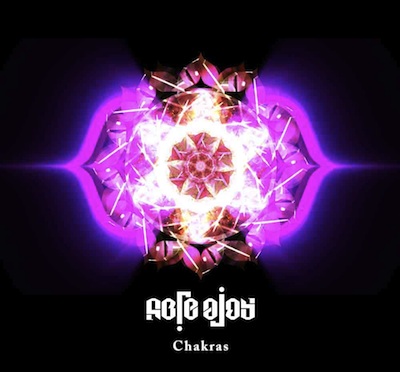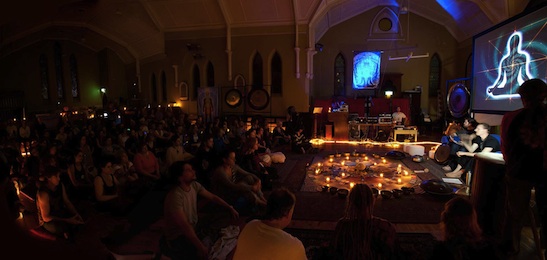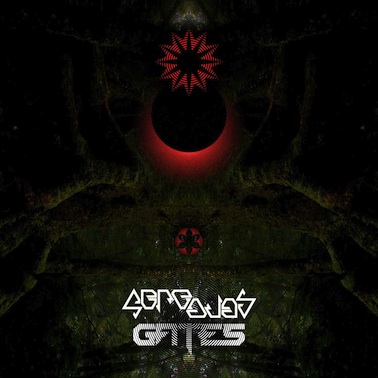When US-based label Secrets of Giza released the Gates CD/DVD this year it was a significant milestone for Scott Baker, the Melbourne-based artist behind the Abre Ojos moniker. The dual disc package captures the “sound and vision for dystopian meditation” of live shows. Baker orchestrates single-take tracks interacting with Quartz Composer visuals prepared to complement the complex audio chains incorporating voice, modular synth, drum machines and various effects.
The live performances provide an interesting point of contrast to the usual focus of most live music and art shows. Where these events use alcohol as a social lubricant, the meditative focus of Abre Ojos’ shows aims for a different atmosphere. Churches are a more likely venue for show utilising multiple projectors and layered visuals with harmonically-rich sounds from a modular synth accompanied by droning vocals.
Abre Ojos’ current set-up for live performances is about a lightyear ahead of the rig Baker was using when I first saw him competing as part of a duo in a battle of the bands in Wagga Wagga early last decade. Performing live electronic music on computers, they progressed to the next round but there the judges didn’t agree that two guys using computers could be considered a band — even though their branding and visuals made it clear they had a bigger focus than performing music.
It was while teaching in Wagga Wagga that Scott Baker developed his interests in art, video, music and generative approaches to all three.
“In terms of sound creation I still consider myself a student, visuals arts was the basis for me and from my uni degree and my visual arts practice I have a depth of material and references already and although I am always learning on the visual side of things, my depth of references and influences for sound creation is not as comprehensive. ”
As a member of the Wagga Space Program he contributed to the Unsound Festival that would inspire the Polish festival that has since appeared in New York, and this year Adelaide.
In 2004 Baker was partnered with Western Australian artist Alan Lamb and built a set of wires that act like a large-scale aeolian harp. These wires produce drones and rhythms, their pitch rising from low frequencies as shifting harmonics caused by the vibrations created by winds.
“Creating the wires with Alan Lamb just outside Wagga Wagga in rural NSW as part of Unsound was an experience that took years to sink in. I remember Alan continuously telling me to slow down, just sit and wait and then later once the wires were completed to just sit and listen. At the time there was plenty of glitch and IDM in my sound library and I was trying to emulate that kind of schizophrenic restless music, chopping and changing and abrupt halts. There is a beauty in digital artefacts, but it was possibly the furthest away from the sound experience of the wires. I wasn’t ready for deep listening at that point, especially because my aural diet was 3-6 minute songs, a track of 20 mins in length was, I thought, forbidden. ”
“Understandably being exposed to Alan’s compositions and direct listening on the wire planted a seed that slowly took root. An other thing that struck me was Alan’s mention of the healing properties of sound and specifically the harmonics coming from the wires. He spoke of his desire to make a platform at some point that would allow a person to sit on it and have the sound of the wires travel through their body, this was something else I wasn’t ready for but returned to later on. ”
While changing winds influence the sounds of Alan Lamb’s wires, they are one influence on the sound of Abre Ojos as Scott Baker explains. His interest in synthesisers was sparked during time in London and the meditative direction that has developed since returning to Australia.
“While in London I started collaboration with Rob Jones (electronicshaman.com) where we formed Look To The Skies on a basic process of getting together once or twice a week, setting up whatever equipment we had, Rob on laptop with soft synths and other instruments, me with a Korg ES-1 Electribe and a rag-tag collection of effect units, and with minimal preparation just recording 20 minute jams, doing some basic level mastering and posting them to the web. We did over 60 tracks like this over a year. This marked the point where the 3-6 minute song was blown away and improvisation became an integral part of my process.”
The return to Australia gave Baker the space for new equipment and the use of modular synthesisers became a key part of the sound of Abre Ojos.
“in 2007 a group called VICMOD kicked off, started by Ross Healy, it was a collection of people from varied backgrounds all wanting to get into modular synthesis by building their own modules. Finally there was the opportunity to have access to the equipment that had made an album like Coil’s Time Machines. We built Elby and CGS modules to start with and the combined experience from the group helped us get power supplies, racks and cases. In under a year I had a 6ru euro-rack modular with 80% of the modules I had built myself in a case I built with a power supply I built. It was amazing! Not only sonically but also aesthetically, this ex-military suitcase covered in black tolex with cables vomiting out the front. The esoteric nature of a modular, the alchemy of electrical control voltage was mesmerising. This was right at the start of the modular revival, there were only a handful of manufacturers, modules had to be bought from OS (except the awesome Elby Designs and CGS stuff). Over a few years it grew to 15ru in size and it was my primary sound source. All of my other synths were sold off in the pursuit for more modules. Listening to oscillators drone on and making small changes, the experiences of listening to Time Machines and also the shifting harmonics of the wires were recalled and the interest in the science (and pseudo-science) of the effect of sound on the human organism was something I started researching.”
Anyone who has a casual interest in sound — such questions as whether there really is a ‘brown note’? — will be aware there are widely varied interpretations of the effect sound has on a human. Psychoacoustics is more than a cool word, there are many discussions around the use of sound in rituals and other applications. The Hindi belief system of chakras is one area that took Scott’s interest and became a topic of research.
“With the wealth of information on the internet, researching each chakra and finding specific notes or frequencies became a psuedo-science nightmare! I could find 3 or 4 different notes that each “expert” associated with a chakra, and then converting the note to a frequency was easy enough until then scratching the surface of the standard western tuning system of A = 440hz. This opened another can of worms when apparently sometime in the early 20th century someone decided that for the first time to fix a frequency to the musical scale. Before that point an A could’ve been 10hz either way depending on the composer, conductor or musician. So saying that a particular specific note with a particular specific frequency specified in the early 20th Century is something that resonates with an energy centre identified in spiritual teachings centuries old was a frustrating experience. I knew that sounds had an effect and I also knew that intention in creation was also crucial and trying to be exact in the creation process was proving frustrating. The answer was simply to forget the rules, forget the dogma, look at the focus of each particular chakra (eg. throat – speaking your truth) and use intution and intention gently sculptured by the research to build a track. Funnily enough the idea of strict following of dogma or ritual and process for spirituality was something that I had already discarded in regards to organised religions, but for the “new age” practices I fell back into the steps of enlightenment – Step 1: Meditate, Step 2: Cleanse with fasting and enemas, Step 3: Contort into excruciating posture. Fuck all that shit! So the lesson learnt for me was to worship how ever I want, to make my church where ever I lay my hat, that the keys to heaven are no longer held by gate keeper priests, swarmis, gurus or shaman- that sitting in the studio tuning an oscillator by using my ears, heart and spirit is as valid a path to enlightenment as a bed of nails or fasting in the desert for 40 days. For that matter riding a bike, a skateboard, listening to the sounds of a river all are valid forms of ‘worship’.”
Worshipping live performance seems a logical extension but it’s an environment that provided an unwelcome contrast to Abre Ojos’ explorations.
“The Chakra release led me to working with a transformational therapist and holistic health practitioner Heath Myers (http://agentofchange.com.au/). I had always found it frustrating playing ambient/drone things in a pub or bar environment. When performing live I wanted to give people a deep listening experience as opposed to background music catching up with friends drinking at the bar. After meeting Heath we talked about crafting a true meditative audiovisual experience, along the lines of a Robert Rich type sleep performance but with a stronger spiritual intention behind it. We formed Coalessence and we held 4 or 5 events. Using a healing system that Heath was trained in called the Liquid Crystals, each event was based on the crystal that aligned to the day the performance was going to be on. For example it might’ve been chrysoprase, clear quartz, or even gold. My part was to create the sound and vision. The process was research the crystal- the molecular structure, geometry and colours for the visuals and then to as said above, use my intuition and intention to craft the sound. Then there was three parts to the event- a simple movement  section based on Tibetan Yoga, a guided meditation from Heath and then the audiovisual journey. From the feedback from some of the audience members it worked well, so well that some people described out of body experiences and deep personal revelations, even physical healing to some degree. It was a blow out that in the right space with the right set up the sounds and images could have those kind of impacts. Seasons (See https://vimeo.com/26057455) Earth Embrace (See https://vimeo.com/27530193), Foresight (See https://vimeo.com/30041183) and The Solar Angel (See https://vimeo.com/32505654) are all studio recordings of the sound and vision for four of the Coalessence events.”
After Chakras and Coalessence came Haxan, an exploration of witchcraft through repurposing an early European film.
“Haxan has been almost a correction of balance in my work between the light and dark. Based on the 1922 movie which is a documentary re-enacted by actors it was a wonderful piece to work with. Being public domain there was the rich visuals to manipulate and the opportunity to research and learn more about the witch hunts of the 15th Century. 500 years later and reading about the stoning, hanging and torture of women that still happens makes it relevant today. Even though things are moving towards balance both between males and females and internally between our own masculine and feminine aspects there is a ways to go. So the darker sound and darker vision felt right and still does moving into my latest release Gates.”
“Gates (http://www.secretsofgiza.com/?p=101) was recorded at the end of 2012, after my performances at the Eclipse Festival in Cairns and over the period of the end of the Mayan calendar into early 2013. The Eclipse festival was full of new age experiences, rainbows and dolphins and unicorns, but there was also a darker undercurrent, not the hedonistic pursuit of pleasure that was there, but a true understanding of our insignificance. The substance ingestion, constant dancing and guru workshops seemed to be shields against the truth of three massive celestial bodies creating a perfect alignment. So Gates is that personal journey of beginning to understand my place in the world, amongst the corruption, the conspiracies, the abominable abhorrent way we treat each other, the animals, the plants and our planet.”
One of the changes in Gates was shorter track lengths, moving away from the meditation aspect of my music into something shorter, darker, more aggressive and to the point. Unlike previous releases there wasn’t an external theme as such to research, such as chakras, witchcraft, elements, etc. Instead there was a deeper personal research, how to find a point of stability again after busting through this artificial threshold of control structures with few strategies to deal with it.
“With the sound creation something that was quite effective was including metallic percussion in Haxan, recordings of meditation bowls, chimes, crystal glasses etc. This expanded into incorporating ritual drumming into Gates a further extension of crafting my own rituals. The visuals are a combination of animated geometry and processed video from three different sci-fi films found on the amazing public domain resource Archive.org. (See https://vimeo.com/72128994) The celestial theme definitely runs through the visuals, but more specifically the human response to the expanded universe we now find ourselves in; a universe of multi-dimensional beings, channelled messages from ascended masters and the breakdown of the control structures of the 0.01%. That scene in the first moments we see people in space in 2001- that female attendant walking with baby steps in a low gravity environment – learning the basics, just to walk, all over again in this unfamiliar environment. If we don’t have our technology to rely on what is left? Is there an internal technology that we still have to realise? Or even just to recognise our true selves outside of the burden of technology. This guy called Jeff Brown said: ‘After your beloved is gone, all efforts to find her outside yourself fail. You have only one choice- to find God within yourself.'”
It’s on this existential note that Abre Ojos leaves us but now you can see the artist’s discography records Baker’s personal journey in sound and vision. He calls himself a student and he’s a keen one, researching aspects of his craft. The material is uncompromising and reflects a process of systematically exploring his practises in creating live electronic music over the last decade.
It’s fascinating to immerse in Abre Ojos’ recorded output and consider how Scott Baker’s aesthetic has both technically and personally evolved.







